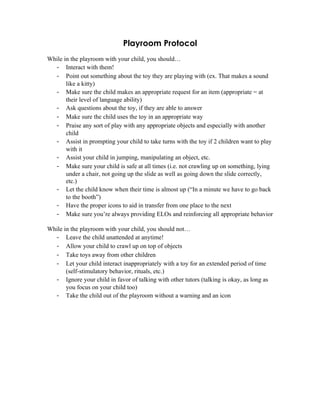
Playroom protocol
- 1. Playroom Protocol While in the playroom with your child, you should… - Interact with them! - Point out something about the toy they are playing with (ex. That makes a sound like a kitty) - Make sure the child makes an appropriate request for an item (appropriate = at their level of language ability) - Ask questions about the toy, if they are able to answer - Make sure the child uses the toy in an appropriate way - Praise any sort of play with any appropriate objects and especially with another child - Assist in prompting your child to take turns with the toy if 2 children want to play with it - Assist your child in jumping, manipulating an object, etc. - Make sure your child is safe at all times (i.e. not crawling up on something, lying under a chair, not going up the slide as well as going down the slide correctly, etc.) - Let the child know when their time is almost up (“In a minute we have to go back to the booth”) - Have the proper icons to aid in transfer from one place to the next - Make sure you’re always providing ELOs and reinforcing all appropriate behavior While in the playroom with your child, you should not… - Leave the child unattended at anytime! - Allow your child to crawl up on top of objects - Take toys away from other children - Let your child interact inappropriately with a toy for an extended period of time (self-stimulatory behavior, rituals, etc.) - Ignore your child in favor of talking with other tutors (talking is okay, as long as you focus on your child too) - Take the child out of the playroom without a warning and an icon